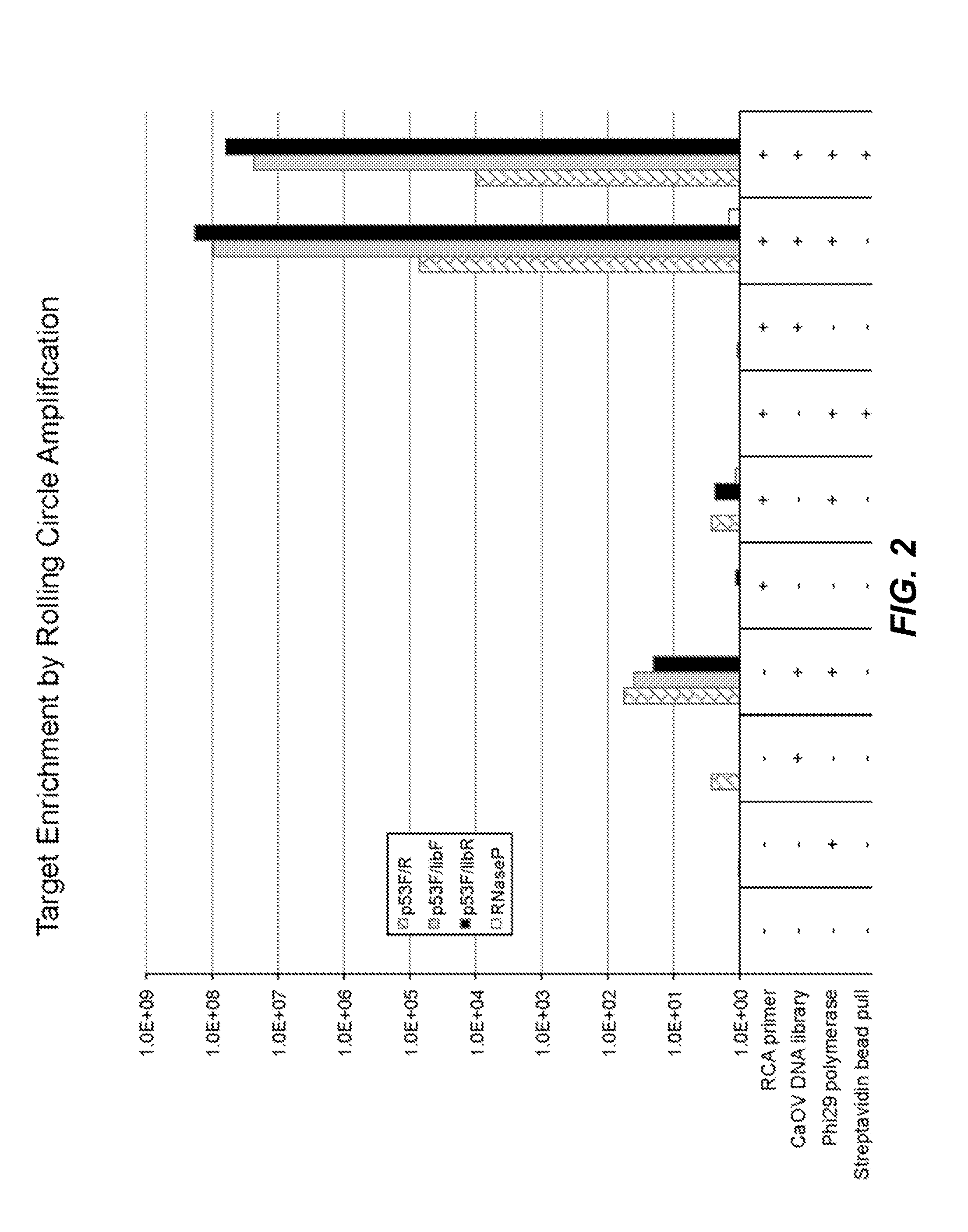Compositions and methods for sensitive mutation detection in nucleic acid molecules
- Summary
- Abstract
- Description
- Claims
- Application Information
AI Technical Summary
Benefits of technology
Problems solved by technology
Method used
Image
Examples
example 1
Rolling Circle Amplification and Dual Cypher Sequencing of a Tumor Genomic Library
[0091]Cancer cells contain numerous clonal mutations, i.e., mutations that are present in most or all malignant cells of a tumor and have presumably been selected because they confer a proliferative advantage. An important question is whether cancer cells also contain a large number of random mutations, i.e., randomly distributed unselected mutations that occur in only one or a few cells of a tumor. Such random mutations could contribute to the morphologic and functional heterogeneity of cancers and include mutations that confer resistance to therapy. Distinguishing clonal mutations from random mutations
[0092]To examine whether malignant cells exhibit a mutator phenotype resulting in the generation of random mutations in genes that would confer chemotherapeutic drug resistance, rolling circle amplification and dual cypher sequencing of present disclosure will be performed on normal and tumor genomic li...
example 2
Rolling Circle Amplification and Dual Cypher Sequencing of a mtDNA Library
[0095]Mutations in mitochondrial DNA (mtDNA) lead to a diverse collection of diseases that are challenging to diagnose and treat. Each human cell has hundreds to thousands of mitochondrial genomes and disease-associated mtDNA mutations are homoplasmic in nature, i.e., the identical mutation is present in a preponderance of mitochondria within a tissue (Taylor and Turnbull, Nat. Rev. Genet. 6:389, 2005; Chatterjee et al., Oncogene 25:4663, 2006). Although the precise mechanisms of mtDNA mutation accumulation in disease pathogenesis remain elusive, multiple homoplasmic mutations have been documented in colorectal, breast, cervical, ovarian, prostate, liver, and lung cancers (Copeland et al., Cancer Invest. 20:557, 2002; Brandon et al., Oncogene 25:4647, 2006). Hence, the mitochondrial genome provides excellent potential as a more specific biomarker of disease than any other yet described, which may allow for imp...
example 3
Targeted Enrichment of Dual Cypher Library Molecules by Rolling Circle Amplification
[0098]High grade serous ovarian carcinoma (HGSC) frequently exhibit somatic TP53 mutations (Cancer Genome Atlas Research Network, Nature 474:609, 2011). Loss of p53 is associated with unfavorable outcome (Kobel et al., 2010, J. Pathol. 222:191-198). Thus, the frequency and clinical value of TP53 mutations in HGSC make TP53 a promising biomarker for early detection and disease monitoring of HGSC. Enrichment methods of the present disclosure were used to enrich TP53 exon 4, a region that is frequently mutated in cancer, from an ovarian cancer cell line.
[0099]CaOV (human ovarian carcinoma cell line) cells were grown in McCoy's 5a Medium supplemented with 10% Fetal Bovine Serum, 1.5 mM / L-glutamine, 2200 mg / L sodium bicarbonate, and Penicillin / Streptomycin. CaOV cells were harvested and DNA was extracted using a DNeasy Blood and Tissue Kit (Qiagen). A target genomic library was created containing whole ge...
PUM
| Property | Measurement | Unit |
|---|---|---|
| Length | aaaaa | aaaaa |
| Error | aaaaa | aaaaa |
Abstract
Description
Claims
Application Information
 Login to View More
Login to View More - Generate Ideas
- Intellectual Property
- Life Sciences
- Materials
- Tech Scout
- Unparalleled Data Quality
- Higher Quality Content
- 60% Fewer Hallucinations
Browse by: Latest US Patents, China's latest patents, Technical Efficacy Thesaurus, Application Domain, Technology Topic, Popular Technical Reports.
© 2025 PatSnap. All rights reserved.Legal|Privacy policy|Modern Slavery Act Transparency Statement|Sitemap|About US| Contact US: help@patsnap.com


